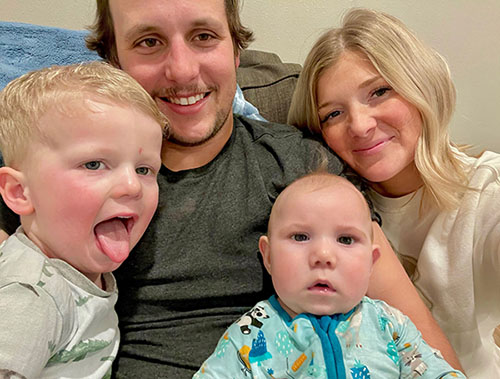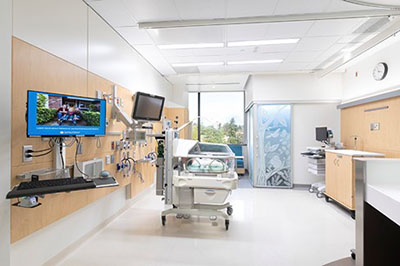A Cool Approach: Why Seattle Children’s NICU Puts Babies ‘On Ice’
5.2.2023 | Amanda Maier

For newborn babies recovering from a difficult birth resulting in a brain injury, Seattle Children’s Neonatal Intensive Care Unit (NICU) team employs a surprising therapy — they lay some babies “on ice.”
On the Pulse shares how this cooling treatment can help newborns heal and stop further damage from happening.
About Hypoxic-Ischemic Encephalopathy
In 2022, the NICU treated 45 patients with Hypoxic-ischemic encephalopathy (HIE), a brain injury that occurs when the brain experiences a decrease in oxygen or blood flow and often requires the patient’s body temperature to be cooled to 33.5 degrees Celsius, or about 92.3 degrees Fahrenheit.
“HIE in newborns is sudden and typically unanticipated,” explained Dr. Ulrike Mietzsch, the co-director of Seattle Children’s Neonatal Neurocritical Care Unit (Neuro NICU). “We can see HIE in babies whose mothers have had uncomplicated, full-term pregnancies. While giving birth, an unexpected event can happen — for example the placenta comes off too early during delivery, or we later learn that the placenta was unable to adequately support the baby.”
Cooling Mattresses
For babies with HIE, getting the right treatment quickly is critical. Community physicians notify experts in Seattle Children’s Neonatology Program when they deliver a baby who has undergone a complicated delivery, has HIE symptoms and meets defined criteria.
Although the baby has already experienced the initial HIE brain injury, the NICU team can administer a cooling treatment to help the baby’s brain and body recover and prevent what’s known as a secondary injury.
To do that, the team lays babies on cooling mattresses specifically designed to lower babies’ temperature and reduce the inflammation in the brain that happens because of the acute injury during birth.
On arrival, the NICU team involves Seattle Children’s Neurology team for urgent evaluation and continuous electroencephalogram (EEG) tests, which measure the electrical activity of the brain and can help the care team monitor to quickly evaluate for seizures, which can occur with HIE.
 This cooling treatment functions much like icing an ankle after a sprain, according to Dr. Mietzsch.
This cooling treatment functions much like icing an ankle after a sprain, according to Dr. Mietzsch.
“Cooling these babies doesn’t change the initial injury, but it does give a baby’s body time to recover and reduces what we call a secondary injury,” she said.
“After the initial HIE injury, the body tries to repair that first injury, but it can go too far, causing additional injury to the brain due to inflammation and too much energy expenditure. By cooling the body’s temperature, we’re lowering the brain’s metabolism and reducing inflammation and swelling.”
The cooling treatment reduces how much energy is required to complete other tasks.
“We’re trying to decrease a patient’s energy output so their brain doesn’t have to work quite as hard as it normally would, which protects the brain from further injury,” added Dr. Nina Natarajan, the co-director of Seattle Children’s Neuro NICU.
Studies indicate if a baby’s temperature is cooled within the first six hours of birth, they have far better rates of surviving and experiencing less long-term symptoms of a brain injury.
Compassionate Improvements
For new parents, watching their newborn receive this type of treatment can be jarring.
The NICU and Neonatology teams have taken steps rooted in compassion to support families whose child is receiving the treatment, like using special cooling blankets so parents can continue to hold their baby while they’re getting cooled.
Babies spend 72 hours on a cooling pad and then their body temperature is slowly increased over six or seven hours to a regular temperature.
When a baby experiences a seizure, there are fewer outward signs than with an older child. Therefore, all babies with HIE are monitored with an EEG to detect and treat seizures as soon as they happen. Once cooling therapy is completed and the baby is stable, magnetic resonance imaging (MRI) is obtained.
Seattle Children’s expert Neuroradiology team views and analyzes images of patients’ brains which can offer insight into the long-term implications of a patient’s HIE injury.
The Best Versions of Themselves
When babies are discharged, long-term developmental follow-up is crucial. While some do not experience long-term health implications from their HIE, others can experience lifelong impacts ranging from difficulty learning to delays developing motor or language skills.
The NICU team works closely with the Infant Therapy team and the University of Washington Medical Center’s Infant Development Follow Up Clinic to make sure patients get the right follow-up care as they grow.
“For some HIE patients, we know there are conditions that could be in their future, like cerebral palsy,” Dr. Natarajan explained. “We want to make sure we support families and get these babies the resources they need so they can hopefully be the best versions of themselves possible. Even in scenarios where we are optimistic there’s not long-term injury, we want to inform families of possible outcomes and resources early.”
Every year, two to three out of every 1,000 live births around the world are diagnosed with HIE, a type of neonatal and pediatric brain injury. To help support Seattle Children’s important work in the NICU, visit give.seattlechildrens.org and designate donations to the ‘NICU.’